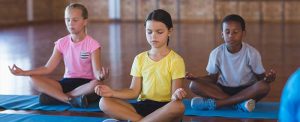 By John M. de Castro, Ph.D.
By John M. de Castro, Ph.D.
In today’s Research News article “Assessing the impact of mindfulness programs on attention-deficit/ hyperactivity disorder in children and adolescents: a systematic review” (See summary below or view the full text of the study at: https://pmc.ncbi.nlm.nih.gov/articles/PMC11730125/) Sultan and colleagues review and summarize the research studies on the effectiveness of mindfulness training in treating the symptoms of attention deficit hyperactivity disorder (ADHD) in children and adolescents. They report that mindfulness training significantly improves attention and reduces hyperactivity and impulsiveness in children and adolescents.
Improve ADHD symptoms in children and adolescents with mindfulness.
CMCS – Center for Mindfulness and Contemplative Studies
This and other Contemplative Studies posts are also available on the Contemplative Studies Blog http://contemplative-studies.org
Study Summary
Sultan MA, Nawaz FA, Alattar B, Khalaf E, Shadan S, El-Abiary N, Tegginmani S, Qasba RK, Jogia J. Assessing the impact of mindfulness programs on attention-deficit/ hyperactivity disorder in children and adolescents: a systematic review. BMC Pediatr. 2025 Jan 14;25(1):32. doi: 10.1186/s12887-024-05310-z. PMID: 39810118; PMCID: PMC11730125. Abstract
Background
Attention Deficit Hyperactivity Disorder (ADHD) is a prevalent neurodevelopmental disorder which poses challenges for the individuals with the disorder and their families. While stimulant medications are effective, a comprehensive approach, including psychosocial and behavioral interventions, is recommended. There is a growing body of research exploring the potential benefits of mindfulness-based interventions for children with ADHD. Our study aims to assess the effectiveness of mindfulness interventions in reducing ADHD symptoms in children and adolescents through a systematic review of relevant studies.
Methods
Following PRISMA guidelines, our systematic review searched PubMed, Cochrane library, Psycinfo, and Scopus from January 2000 to August 2022. We included studies focusing on mindfulness for pediatric ADHD, comprising various study designs with a minimum 8-week duration. Descriptive statistics summarized results, while risk of bias was assessed using Cochrane RoB and ROBANS tools. The quality of RCTs was further evaluated using the Correlation of Quality Measures tool.
Results
In the initial search, 450 records were identified, and after removing duplicates, 339 underwent screening. Forty-one studies underwent full text assessment for eligibility, with 11 studies meeting inclusion criteria, including seven RCTs, two Quasi RCTs, and three cohort studies. These studies, conducted in five countries, involved participants aged 7 to 18 years. Six studies showed improvement in hyperactivity/inattentive symptoms, and five studies showed improvement in impulsivity.
Conclusions
This systematic review demonstrates the potential benefits of mindfulness programs on ADHD symptoms in children and adolescents. This study emphasizes the need for high-quality research to explore mindfulness-based interventions for ADHD management in younger populations.








